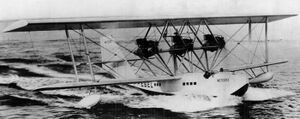Engineering:SPCA Météore 63
| Météore 63 | |
|---|---|

| |
| Role | Airliner[1] |
| National origin | France |
| Manufacturer | SPCA |
| First flight | 3 September 1925[1] |
| Primary user | Air Union Lignes d'Orient[2][3][4] |
| Number built | 3[1] |
The SPCA Météore 63 (French for "Meteor") was a flying boat built in France in the 1920s for use as an airliner.[1] It was the first product of the SPCA company (Société Provençale de Constructions Aéronautiques), founded by Laurent-Dominique Santoni when he left CAMS in 1925.[5]
Design
The Météore was a conventional biplane design for its day, with single-bay wings of unequal span braced with struts and wire.[4][6] The lower wing was mounted to the top of the aircraft's hull, with trusswork above it that carried three engines mounted tractor-fashion in the interplane gap.[4][6] The lower wing also carried outrigger pontoons near its tips.[4][6] The empennage was of conventional design, with the stabilizer carried part-way up the fin.[4][6] The flight deck was open but the separate cabin, with seating for six passengers, was fully enclosed within the hull and electrically heated.[6] The structure was of timber throughout except for the struts that carried the engines, which were steel tube.[6] The wings were covered in fabric.[6]
Operational history
In 1926, SPCA entered a Météore in a competition for transport seaplanes organised by the French Undersecretariat for Aeronautics,[6] the Grand Prix des Hydravions de Transport Multimoteurs (Grand Prize of multi-engine transport seaplanes).[4] Piloted by Ernest Burri, the Météore won first place and a FF 100,000 prize.[7] It was also the first French transport seaplane to which Bureau Veritas awarded a first-class airworthiness certificate.[6] The same year, Lignes Aériennes Latécoère trialled the type on a mail route between Marsailles and Algiers,[6] the first trip taking place on 22 October.[4]
Because of the Météore's long range, Air Union Lignes d'Orient (AULO) ordered an example in January 1927.[4][8] In October that year, Maurice Noguès flew it from Marsailles to Beirut but crashed and sank off Naples during the return journey.[4][8] Nevertheless, AULO purchased a second example in May 1928, and with this aircraft inaugurated a regular service between the two cities on 6 June 1929.[8] On 17 February 1931, the Météore also established the Paris–Saigon route for Air Orient, which had been formed by a merger of AULO and Air Asie the previous year. Over its lifespan, the Météore covered 100,000 km (62,000 mi).[4]
Operators
- Lignes Aériennes Latécoère
- Air Union Lignes d'Orient
Specifications
Data from Parmentier 1998
General characteristics
- Capacity: six passengers
- Length: 13.05 m (42 ft 10 in)
- Wingspan: 21.20 m (69 ft 4 in)
- Height: 5.21 m (17 ft 1 in)
- Wing area: 103.0 m2 (1,108 sq ft)
- Empty weight: 3,400 kg (7,480 lb)
- Gross weight: 5,200 kg (9,240 lb)
- Powerplant: 3 × Hispano-Suiza 8Ac , 130 kW (180 hp) each
Performance
- Maximum speed: 167 km/h (104 mph, 90 kn)
- Range: 970 km (606 mi, 527 nmi)
- Service ceiling: 4,500 m (14,800 ft)
See also
Related lists
Notes
- ↑ 1.0 1.1 1.2 1.3 Parmentier 1998
- ↑ The Illustrated Encyclopedia of Aircraft, p.2860
- ↑ Taylor 1989, p.835
- ↑ 4.0 4.1 4.2 4.3 4.4 4.5 4.6 4.7 4.8 4.9 L'Association des Amis du Vieux La Ciotat
- ↑ Hartmann 2004, p.8
- ↑ 6.0 6.1 6.2 6.3 6.4 6.5 6.6 6.7 6.8 6.9 "The Paris Aero Show 1926", p.788
- ↑ "French Competition for Transport Seaplanes", p.491
- ↑ 8.0 8.1 8.2 Hartmann 2000, p.6
References
- l'Association des Amis du Vieux La Ciotat. "La SPCA". Le Musée de l' Association des Amis du Vieux La Ciotat. http://www.museeciotaden.org/chantiers/autour/spca.htm.
- "French Competition for Transport Seaplanes". Flight: 491. 12 August 1926. http://www.flightglobal.com/pdfarchive/view/1926/1926%20-%200561.html. Retrieved 2011-03-03.
- Hartmann, Gérard (2000). "Les hydravions FBA d'Air-Union". Dossiers historiques et techniques aéronautique française. http://www.hydroretro.net/etudegh/fbaunion.pdf.
- Hartmann, Gérard (2004). "Les hydravions CAMS". Dossiers historiques et techniques aéronautique française. http://www.hydroretro.net/etudegh/cams.pdf.
- Liron, Jean (June 1989). "Les SPCA: Le Météore 63 et Le SPCA I type 10" (in Fr). Le Fana de l'Aviation (235): 19–28.
- The Illustrated Encyclopedia of Aircraft. London: Aerospace Publishing.
- "The Paris Aero Show 1926". Flight: 775–91. 2 December 1926. http://www.flightglobal.com/pdfarchive/view/1926/1926%20-%200875.html. Retrieved 2011-03-03.
- Parmentier, Bruno (1998). "S.P.C.A. 'Météore' 63". Aviafrance. http://www.aviafrance.com/s-p-c-a-meteore-63-aviation-france-4569.htm.
- Taylor, Michael J. H. (1989). Jane's Encyclopedia of Aviation. London: Studio Editions.
 |


